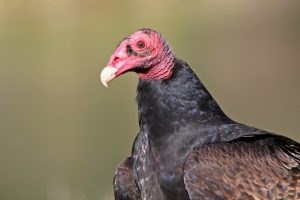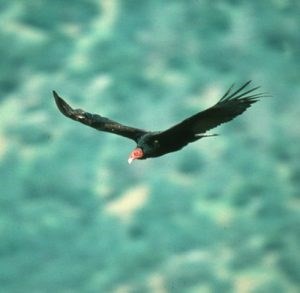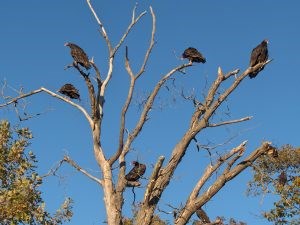This content was originally published by the Longmont Observer and is licensed under a Creative Commons license.
As fall approaches, I have started to see raptors beginning to migrate. The other day I saw about 20 turkey vultures in the trees at the pond near Roger’s Grove. I figured now might be a good time to write about these amazing birds.
Turkey vultures have bald, red heads which sometimes may have sparse black stubble on it. Their bill is sharply hooked and pale yellow to cream-colored. From a distance, turkey vultures appear to be black, but up close you can see that they are actually dark brown. The undersides of their wingtip feathers are a paler brown color, giving them the appearance of being two-toned when looking up at them in the sky. In flight, turkey vultures have long, broad wings and a tail that extends beyond the tips of their feet. Turkey vultures fly with their wings in a slight v-shape, called a dihedral, and take very few wingbeats. They like to soar on the thermals (rising columns of air), but appear wobbly as they do so, tipping from side to side. In terms of size, turkey vultures are larger than most raptors, but smaller than eagles. Their wingspan can be up to six feet, are up to two feet tall, and may weigh up to six pounds.

Turkey vultures are somewhat unique in that they don’t have a voice box. Instead, they communicate with each other using a series of grunts and hisses. These vocalizations are limited to when the bird is feeding or at the nest.
Turkey vultures can be found in open areas of suburbs as well as open areas in the countryside. They can be found flying low to the ground as they sniff out food (more on their sense of smell later), or near food sources such as trash heaps and landfills. They often occur in small groups, but roost in larger group numbers in trees. If the day is sunny, you can find them soaring overhead by 9 a.m. A group of flying turkey vultures is called a kettle, whereas a group of roosting vultures is called a committee. When feeding in a group, turkey vultures are known as a wake.
Turkey vultures have an excellent sense of smell which allows them to find carrion (dead animals) buried underneath leaf litter. In fact, they can find dead animals that are only about 12 hours old and have been known to smell dead animals that are a mile away. Their olfactory system is the most developed of all the birds.

They mainly eat mammals, but will sometimes eat other dead animals as the opportunity arises. Turkey vultures prefer food that has been freshly killed, but will wait for it to become softer which allows them to pierce the skin more easily. They will start with the softest part of the dead animal first. As skillful feeders, turkey vultures have even been known to not eat less preferred parts of animals such as the scent glands of skunks. Having a bald head is an advantage when feeding because turkey vultures often stick their heads into carcass cavities. The bald head prevents blood and tissue from sticking to the head. They almost never attack and kill live animals to eat. Because they are gregarious birds, turkey vultures are attracted to other vultures that are feeding, and will congregate near carcasses, but only one bird will feed at a time.
Turkey vultures have amazing immune systems that allow them to eat carrion without contracting various diseases such as botulism and salmonella. In addition, they often urinate on themselves after eating which kills bacteria and cools the birds off.
Like other birds, turkey vultures have a ritualized breeding display that is used to form pair bonds between males and females. The birds will gather in a circle on the ground and hop with wings partially spread. They may also perform a display in the air with one vulture following another with both birds flapping and diving together.
Turkey vultures don’t actually build nests. Instead, they scrape a spot on the ground in the soil or leaves. They will pull nearby objects close to the scrape. Turkey vultures prefer to nest farther away from civilization, but will use a variety of locations. These locations may include rock ledges or crevices, caves, hollow logs, mammal burrows, or previously abandoned hawk or heron nests. Once a nest site is located, turkey vultures may reuse the same nest for many years. Nests have been particularly difficult for researchers to locate as they as so well-hidden.

The turkey vulture lays one clutch of eggs per breeding season, consisting of one to three eggs. Both parents incubate the eggs. The eggs hatch after 34 to 40 days. Initially, one parent will stay with the young at all times, tapering off as the young get bigger. Both parents feed the young, but unlike other raptors, they do not feed meat to the young. Instead, they regurgitate the food they have eaten. When the young are confronted by a nest predator, they respond by hissing and regurgitating. In fact, the primary defense turkey vultures have against predators, whether young or adult, is regurgitating partially digested food at the predator. The young leave the nest at about nine or ten weeks after hatching.
Look for turkey vultures to be migrating through Longmont from now until October. You are most likely to catch them soaring on the thermals during the day, but you may be able to observe some that have congregated to roost or feed. There is a roost of some 50 turkey vultures located at the intersection of Francis and Longs Peak Avenue. If you get there before 9 a.m. or 10 a.m. you will have the opportunity to see them. Turkey vultures are homely, but interesting birds to watch.


